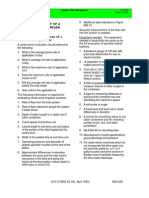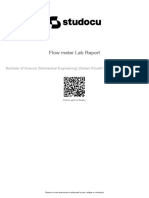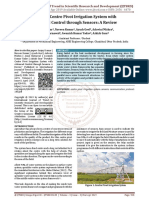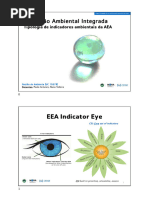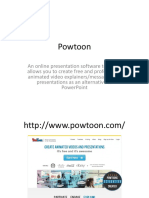0 ratings0% found this document useful (0 votes)
Act 2 Sprinkler Irrigation System PDF
Act 2 Sprinkler Irrigation System PDF
Uploaded by
abuThis document outlines a study to evaluate the effects of a sprinkler irrigation system on wheat yield and water productivity. The study will compare four irrigation depths applied using sprinklers. Parameters like sprinkler discharge, radius of throw, distribution pattern, and relationships between pressure, discharge and radius will be measured. Crop water use efficiency under different treatments will also be calculated to analyze the costs and benefits of the sprinkler system for wheat production.
Copyright:
© All Rights Reserved
Available Formats
Download as PDF, TXT or read online from Scribd
Download as pdf or txt
Act 2 Sprinkler Irrigation System PDF
Act 2 Sprinkler Irrigation System PDF
Uploaded by
abu0 ratings0% found this document useful (0 votes)
This document outlines a study to evaluate the effects of a sprinkler irrigation system on wheat yield and water productivity. The study will compare four irrigation depths applied using sprinklers. Parameters like sprinkler discharge, radius of throw, distribution pattern, and relationships between pressure, discharge and radius will be measured. Crop water use efficiency under different treatments will also be calculated to analyze the costs and benefits of the sprinkler system for wheat production.
Original Title
Act 2 sprinkler irrigation system.pdf
Copyright
© © All Rights Reserved
Available Formats
PDF, TXT or read online from Scribd
Share this document
Did you find this document useful?
Is this content inappropriate?
This document outlines a study to evaluate the effects of a sprinkler irrigation system on wheat yield and water productivity. The study will compare four irrigation depths applied using sprinklers. Parameters like sprinkler discharge, radius of throw, distribution pattern, and relationships between pressure, discharge and radius will be measured. Crop water use efficiency under different treatments will also be calculated to analyze the costs and benefits of the sprinkler system for wheat production.
Copyright:
© All Rights Reserved
Available Formats
Download as PDF, TXT or read online from Scribd
Download as pdf or txt
0 ratings0% found this document useful (0 votes)
Act 2 Sprinkler Irrigation System PDF
Act 2 Sprinkler Irrigation System PDF
Uploaded by
abuThis document outlines a study to evaluate the effects of a sprinkler irrigation system on wheat yield and water productivity. The study will compare four irrigation depths applied using sprinklers. Parameters like sprinkler discharge, radius of throw, distribution pattern, and relationships between pressure, discharge and radius will be measured. Crop water use efficiency under different treatments will also be calculated to analyze the costs and benefits of the sprinkler system for wheat production.
Copyright:
© All Rights Reserved
Available Formats
Download as PDF, TXT or read online from Scribd
Download as pdf or txt
You are on page 1/ 27
O N F A R M E VA L UAT I O N O F
S PRI NKLER I RRI GAT I ON
SYSTEM ON YIELD AND
WAT E R P RO D U C T I V I T Y O F
WHEAT
INTRODUCTION • The water is precious and limited resource that is essential for
agricultural production, which must be conserved and used
judiciously
• The main objective of irrigation is to apply the optimum amount
of water to the crop root zone that the crop needs for
development and also that cannot be provided by rains
• An ideal irrigation system should minimize the losses, and apply
the water uniformly
• In the sprinkler method of irrigation, water is sprayed into the air
and allowed to fall on the ground surface somewhat resembling
rainfall
10/24/2023 Sample Footer Text 2
INTRODUCTION
• The sprinkler irrigation is suitable for all types of soils
and Recommended for the irrigation of open field
crops like potato, leafy vegetables, cotton, oil seeds,
pulses, cereals, jowar, tobacco, groundnut
• The sprinkler irrigation helps to conserve precious
water up to 50 percent and can irrigate 2 to 3 times
the area compared to surface irrigation
• Sprinkler irrigation is an improvement over
conventional surface irrigation
10/24/2023 Sample Footer Text 3
OBJECTIVES • To evaluate hydraulic performance of sprinkler
irrigation system under wheat
• To demonstrate sprinkler irrigation system for wheat
production
• To evaluate the effects of sprinkler irrigation system
on yields and water productivity of wheat
10/24/2023 Sample Footer Text 4
M ATE RI A LS A N D
METHODS
10/24/2023 Sample Footer Text 5
M AT E RIA L • The materials used for this study include; measuring
tape, pegs, rope, hoe, digger, double ring
infiltrometer, core sampler, blade, pump, pipes,
sprinkler nozzles, fittings , risers, gum and
hydrometer apparatus
10/24/2023 Sample Footer Text 6
METHODOLOGY
10/24/2023 Sample Footer Text 7
E X P E R I M E N TA L • The study was conducted at omonada wereda
SITE districts of Jimma zone of Oromia Regional State of
Ethiopia
10/24/2023 Sample Footer Text 8
TRE ATME N TS AN D E XPE RI ME NTAL
DESIGN
• The experiment was laid out in RCBD with three replications
• The treatments for the experiment consist of four levels of
irrigation depths with sprinkler irrigation method
• The field experiment was consisted of 3 laterals of sprinkler
irrigation covering the study area
10/24/2023 Sample Footer Text 9
WO RK I NG • Small spraying size nozzles will be placed on pipes of
certain height known as riser pipes
PRINCIPLE
• The nozzles mounted on the riser pipes will be fixed
at uniform intervals along the length of the pipe laid
on the ground surface called as lateral pipes
• The sprinkler heads will be mounted on the risers
which are above the crop height and rotate through
360o, to irrigate the experimental area
10/24/2023 Sample Footer Text 10
PA R A M E T E R T O B E
E S TI M ATE D
10/24/2023 Sample Footer Text 11
MEASUREMENT
• The experiment was proposed to conduct at five
OF D I S CH A RGE different operating pressures of 2.0, 2.5, 3.0, 3.5 and
4.0 kg/cm
• The required operating pressure at the nozzle would
be adjusted by the valve and bypass arrangement
• To measure the discharge from the nozzle at sprinkler
position, diameter rubber tube had to be fixed at one
end of nozzle and its other end had to be put in the
plastic bucket of 20 liter capacity
10/24/2023 Sample Footer Text 12
MEASUREMENT
• The wetted radius of throw for each mini-sprinkler
OF RADIUS OF would be measured at different pressures ranging
THROW from 2.0 to 4.0 kg/cm2 with an increment of 0.5
kg/cm2 by gradually increasing the pressure
• It will be measured directly by the measuring tape
from the center of the sprinkler head to the end of
water throw
10/24/2023 Sample Footer Text 13
NOZZLE SIZE • The soil infiltration rate limits the application rate and
AND will affect the selection of the proper sprinkler, nozzle
C A PAC I T Y sizes, flow rates, pressure, and sprinkler spacing
• The application rate is determined by the nozzle size
and pressure at given spacing
• The discharge requirements of the sprinkler
determine the sprinkler size to use
10/24/2023 Sample Footer Text 14
P R E C I P I TAT ION • Capacity of the sprinkler system: The capacity of the
RATE sprinkler system will be calculated using relationship
adapted by Michael
• Rate of application: The rate of application for a single
sprinkler will be calculated using the equation
• Discharge of sprinkler nozzle: According to Michael,
the discharge will be determined by using orifice flow
formula as follows
10/24/2023 Sample Footer Text 15
• According to Egharevba , selecting a
suitable pump, it is necessary to
determine the maximum total head
against which the pump is working
• It is made up of the summation of
P OW E R maximum head required at the main to
REQUIREMENTS operate the sprinkles on the laterals at
the required pressure, including, the
FOR PUMPING riser height, maximum friction loss in
WA T E R the main and in the suction line, ,
elevation difference between the
pump and the junction of the lateral
and main, and elevation difference
between the pressure and the source
of the irrigation water after drawdown
10/24/2023 Sample Footer Text 16
P OW E R R E Q U I R EM E NT S F O R
P U M P I N G WA T E R
• The power required to pump water into the system will be
obtained from the equation 7 below as reported by Jensen, and
Egharevba, ; WHP is the water horsepower, BHP is the Brake
horsepower, EP is the pump efficiency
10/24/2023 Sample Footer Text 17
DISTRIBUTION • To determine the water distribution pattern in mini-
PAT T E R N sprinkler irrigation method, the tests will be
conducted for single sprinkler head
• For single mini-sprinkler head pattern, the
precipitation depth in catch cans placed at grid of 3 x
3 m spacing and 2 x 2 m spacing for Super 10 nozzle
will be measured
• The observed depths of water in each test will be
used to draw contours for water depth distribution
10/24/2023 Sample Footer Text 18
PRESSURE – DISCHARGE – RADIUS
O F T H ROW R E L AT I O N S H I P
• The mathematical relationships between pressure – discharge
and pressure – radius of throw will be developed from
observation data on pressure, discharge and radius of throw
• The best-fit equation will be decided on the basis of regression
coefficient
• The value of r2 of polynomial equation will be higher than those
of linear, logarithmic, power and exponential
10/24/2023 Sample Footer Text 19
WAT E R U S E • Crop water use efficiency : The crop water use
efficiency is the yield harvested in kg per ha-mm of
EFFICIENCY total water used
• Irrigation water use efficiency : field water use
efficiency is the yield harvested per ha-mm of net
depth infiltrated
10/24/2023 Sample Footer Text 20
• The cost and benefit of each treatment
will be analyzed partially, yield and
economic data will be calculated to
compare the advantage of different
furrow irrigation methods and application
levels of each treatment
COST BENEFIT
• Total water cost for season will be
RAT IO A ND calculated by multiplying the water unit
price by the total amount of irrigation
NET RETURN water required for wheat crop
A N A LY S I S • Net return and benefit-cost ratio due to
irrigation will be calculated according to
as follows: The benefit cost ratio in ETB
or ETB measures the increase in net
return which will be generated by total
cost expenditure
10/24/2023 Sample Footer Text 21
BCR • The net return for additional area for harvested marketable yield
will be calculated as the difference between the sum of the cost
of labor for combination of irrigation methods and application
levels, the cost of water that will be saved from application
levels, and the revenue lost due to yield decreases resulting
from this factor protocol is given as; NRA is Net returns of
additional area , LS is Labor saved from irrigation system , WS
is Volume of water saved , P is Unit price per kilogram of potato
yield and G is Unit cost of labor per irrigation per ha the extra
irrigable land area which could be served by the irrigation water
saved per hectare will be determined by dividing the total saved
water per hectares of land to be irrigated, the extra land will be
obtained by multiplying the change in net income by the area
saved
10/24/2023 Sample Footer Text 22
S TATIS TICAL • The collected data will be analyzed using R statistical
software Mean separation will be carried out using
A N A LY S I S
least significance difference test at 5% probability
level
10/24/2023 Sample Footer Text 23
R E S U LT A N D • Land preparation was done
DISCUSSION • Wheat sawing was done
• Installation of the technology was done
• Preliminary test of the technology on wheat farm was
done
10/24/2023 Sample Footer Text 24
• Note: the result obtained in table1 is
evaluation of the sprinkler during the
preliminary test on field
FIG 3 PICTURE
TAK EN DUR ING • The rest of the data were not collected
PR E L I MI NA RY TE S T due to continuous rain fall throughout
OF THE SPRINKLER the irrigation season
ON WHEAT CROP • Therefore it require to extend the
activity for other working duration to
complete it
10/24/2023 Sample Footer Text 25
C ON C LUSIONS AN D
R E C O MME N DATIO NS
• On farm Evaluation of the sprinkler was done only at preliminary
stage and its effect on the yield and yield component of the
wheat was not done due to continuous rain fall throughout the
irrigation season
• Therefore depending on the result obtained and the mentioned
reasons it is recommended to reevaluation of the technology at
normal condition and at on irrigation season
10/24/2023 Sample Footer Text 26
REFERENCE
10/24/2023 Sample Footer Text 27
You might also like
- 5.3.4 Journal - Describing Distributions (Journal)No ratings yet5.3.4 Journal - Describing Distributions (Journal)6 pages
- Sprinkler Irrigation System (Autosaved)No ratings yetSprinkler Irrigation System (Autosaved)132 pages
- An Extraordinary Life - Lee O. Coldren 1943-2012No ratings yetAn Extraordinary Life - Lee O. Coldren 1943-201214 pages
- Lect4b - Pressureized Irrigation-Apr 3-Ap25No ratings yetLect4b - Pressureized Irrigation-Apr 3-Ap25143 pages
- Lec 1 Introduction to Irrigation and Methods RUN 2 CopyNo ratings yetLec 1 Introduction to Irrigation and Methods RUN 2 Copy74 pages
- Hydrology, Irrigation and Flood Management L4/T1 (Civil Engineering Department)No ratings yetHydrology, Irrigation and Flood Management L4/T1 (Civil Engineering Department)21 pages
- Definition of Yield, Methods To Find Dependable Yield, Estimation of Maximum Flood Discharge.No ratings yetDefinition of Yield, Methods To Find Dependable Yield, Estimation of Maximum Flood Discharge.18 pages
- TKP3501 Farm Mechanization & Irrigation Topic: Micro IrrigationNo ratings yetTKP3501 Farm Mechanization & Irrigation Topic: Micro Irrigation41 pages
- Water Drainage System: A Presentation ON Taken AT PWD, Gangapur City (SWM)No ratings yetWater Drainage System: A Presentation ON Taken AT PWD, Gangapur City (SWM)32 pages
- CE532, Wastewater Engineering: Lecture 3 & 4 Sewage & Stormwater Quantity EstimationNo ratings yetCE532, Wastewater Engineering: Lecture 3 & 4 Sewage & Stormwater Quantity Estimation24 pages
- Measurement of Strains Induced On A Three-Bottom MoldboardNo ratings yetMeasurement of Strains Induced On A Three-Bottom Moldboard33 pages
- Week-01-Tutorials-PBM5144 and PAM5143 Formation Evaluation - Jan2021-SemesterNo ratings yetWeek-01-Tutorials-PBM5144 and PAM5143 Formation Evaluation - Jan2021-Semester43 pages
- Research Designs & Standards Organisation (R.D.S.O.) : Summer Training ReportNo ratings yetResearch Designs & Standards Organisation (R.D.S.O.) : Summer Training Report76 pages
- Justification of Technological Solutions For IrrigNo ratings yetJustification of Technological Solutions For Irrig7 pages
- Effect of Pile Foundation On Groundwater FlowNo ratings yetEffect of Pile Foundation On Groundwater Flow18 pages
- Fluid Mechanics And Fire Hydraulics Calculation - module 5No ratings yetFluid Mechanics And Fire Hydraulics Calculation - module 514 pages
- Water Resources and Hydrology - Lecture 3No ratings yetWater Resources and Hydrology - Lecture 317 pages
- Trs 398 Protocol For Photons: Moderator: Mrs. Reena Sharma Presented By: Parikshit SalariaNo ratings yetTrs 398 Protocol For Photons: Moderator: Mrs. Reena Sharma Presented By: Parikshit Salaria65 pages
- LECTURE 2 Water Requirements of Crops 2No ratings yetLECTURE 2 Water Requirements of Crops 220 pages
- Portable Centre Pivot Irrigation System With Advanced Control Through Sensors A ReviewNo ratings yetPortable Centre Pivot Irrigation System With Advanced Control Through Sensors A Review4 pages
- Civil Engineering Department 2 Year Report In: Sprinkler IrrigationNo ratings yetCivil Engineering Department 2 Year Report In: Sprinkler Irrigation11 pages
- Class Notes Spray Calibration - Boom Height Adjustment and Study of OverlappingNo ratings yetClass Notes Spray Calibration - Boom Height Adjustment and Study of Overlapping70 pages
- Systematic Methods of Water Quality Parameters Analysis: Analytical MethodsFrom EverandSystematic Methods of Water Quality Parameters Analysis: Analytical Methods1/5 (1)
- Groundwater Technology Handbook: A Field Guide to Extraction and Usage of GroundwaterFrom EverandGroundwater Technology Handbook: A Field Guide to Extraction and Usage of Groundwater5/5 (1)
- 1 - Slides GA Tipologia de Indicadores Ambientais AEA 21 - 22No ratings yet1 - Slides GA Tipologia de Indicadores Ambientais AEA 21 - 2215 pages
- Stabilization of Black Cotton Soil Using Rbi Grade-81: B. Tech. Major Project ReportNo ratings yetStabilization of Black Cotton Soil Using Rbi Grade-81: B. Tech. Major Project Report51 pages
- Tardigrades From The "Sierra de San Miguelito" and "Sierra de Alvarez" Near The Urban Area of San Luis Potos I, MexicoNo ratings yetTardigrades From The "Sierra de San Miguelito" and "Sierra de Alvarez" Near The Urban Area of San Luis Potos I, Mexico1 page
- Independent Schools NSW (Combined Non Teaching Staff) Enterprise Agreement 2010 - 2011No ratings yetIndependent Schools NSW (Combined Non Teaching Staff) Enterprise Agreement 2010 - 201166 pages
- Norris, M., & Oppenheim, C. (2007) - Comparing Alternatives To The Web of Science For Coverage of The Social Sciences LiteratureNo ratings yetNorris, M., & Oppenheim, C. (2007) - Comparing Alternatives To The Web of Science For Coverage of The Social Sciences Literature9 pages
- Using The Circuitmaster 4000M Precision Active Oscilloscope For Circuit AnalysisNo ratings yetUsing The Circuitmaster 4000M Precision Active Oscilloscope For Circuit Analysis8 pages
- Contingent Bill of The ................................................................ DepartmentNo ratings yetContingent Bill of The ................................................................ Department1 page
- 5.3.4 Journal - Describing Distributions (Journal)5.3.4 Journal - Describing Distributions (Journal)
- Lec 1 Introduction to Irrigation and Methods RUN 2 CopyLec 1 Introduction to Irrigation and Methods RUN 2 Copy
- Hydrology, Irrigation and Flood Management L4/T1 (Civil Engineering Department)Hydrology, Irrigation and Flood Management L4/T1 (Civil Engineering Department)
- Definition of Yield, Methods To Find Dependable Yield, Estimation of Maximum Flood Discharge.Definition of Yield, Methods To Find Dependable Yield, Estimation of Maximum Flood Discharge.
- TKP3501 Farm Mechanization & Irrigation Topic: Micro IrrigationTKP3501 Farm Mechanization & Irrigation Topic: Micro Irrigation
- Water Drainage System: A Presentation ON Taken AT PWD, Gangapur City (SWM)Water Drainage System: A Presentation ON Taken AT PWD, Gangapur City (SWM)
- CE532, Wastewater Engineering: Lecture 3 & 4 Sewage & Stormwater Quantity EstimationCE532, Wastewater Engineering: Lecture 3 & 4 Sewage & Stormwater Quantity Estimation
- Measurement of Strains Induced On A Three-Bottom MoldboardMeasurement of Strains Induced On A Three-Bottom Moldboard
- Week-01-Tutorials-PBM5144 and PAM5143 Formation Evaluation - Jan2021-SemesterWeek-01-Tutorials-PBM5144 and PAM5143 Formation Evaluation - Jan2021-Semester
- Research Designs & Standards Organisation (R.D.S.O.) : Summer Training ReportResearch Designs & Standards Organisation (R.D.S.O.) : Summer Training Report
- Justification of Technological Solutions For IrrigJustification of Technological Solutions For Irrig
- Fluid Mechanics And Fire Hydraulics Calculation - module 5Fluid Mechanics And Fire Hydraulics Calculation - module 5
- Trs 398 Protocol For Photons: Moderator: Mrs. Reena Sharma Presented By: Parikshit SalariaTrs 398 Protocol For Photons: Moderator: Mrs. Reena Sharma Presented By: Parikshit Salaria
- Portable Centre Pivot Irrigation System With Advanced Control Through Sensors A ReviewPortable Centre Pivot Irrigation System With Advanced Control Through Sensors A Review
- Civil Engineering Department 2 Year Report In: Sprinkler IrrigationCivil Engineering Department 2 Year Report In: Sprinkler Irrigation
- Class Notes Spray Calibration - Boom Height Adjustment and Study of OverlappingClass Notes Spray Calibration - Boom Height Adjustment and Study of Overlapping
- Systematic Methods of Water Quality Parameters Analysis: Analytical MethodsFrom EverandSystematic Methods of Water Quality Parameters Analysis: Analytical Methods
- Groundwater Technology Handbook: A Field Guide to Extraction and Usage of GroundwaterFrom EverandGroundwater Technology Handbook: A Field Guide to Extraction and Usage of Groundwater
- 1 - Slides GA Tipologia de Indicadores Ambientais AEA 21 - 221 - Slides GA Tipologia de Indicadores Ambientais AEA 21 - 22
- Stabilization of Black Cotton Soil Using Rbi Grade-81: B. Tech. Major Project ReportStabilization of Black Cotton Soil Using Rbi Grade-81: B. Tech. Major Project Report
- Tardigrades From The "Sierra de San Miguelito" and "Sierra de Alvarez" Near The Urban Area of San Luis Potos I, MexicoTardigrades From The "Sierra de San Miguelito" and "Sierra de Alvarez" Near The Urban Area of San Luis Potos I, Mexico
- Independent Schools NSW (Combined Non Teaching Staff) Enterprise Agreement 2010 - 2011Independent Schools NSW (Combined Non Teaching Staff) Enterprise Agreement 2010 - 2011
- Norris, M., & Oppenheim, C. (2007) - Comparing Alternatives To The Web of Science For Coverage of The Social Sciences LiteratureNorris, M., & Oppenheim, C. (2007) - Comparing Alternatives To The Web of Science For Coverage of The Social Sciences Literature
- Using The Circuitmaster 4000M Precision Active Oscilloscope For Circuit AnalysisUsing The Circuitmaster 4000M Precision Active Oscilloscope For Circuit Analysis
- Contingent Bill of The ................................................................ DepartmentContingent Bill of The ................................................................ Department














